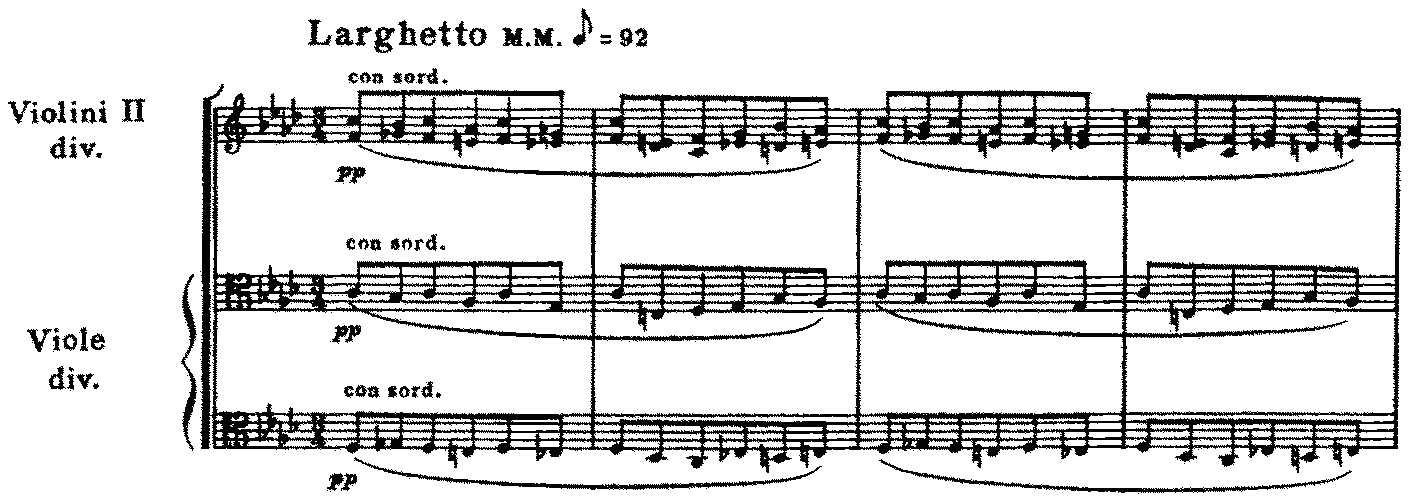Dramatic Vocalise Database
Igor Stravinsky (1882–1971)
Le rossignol (1908, 1913–14)
Igor Stravinsky (1882–1971) includes dramatic vocalization in act 1 of his opera Le Rossignol, a lyric tale in three acts to a libretto by Stepan Mitusov, based on a tale by Hans Christian Andersen. The first act was begun shortly before the death of Rimsky-Korsakov in 1908; the second and third acts were composed in 1913–14.
Despite Richard Taruskin’s statement that “there is little in the exuberantly decorative score [of Le Rossignol] that cannot be associated with the idiom of such older Rimsky-Korsakov pupils as Anatoly Lyadov and especially Nikolay Tcherepnin,” the orchestral introduction bears the unmistakable imprint of Debussy, especially the opening measures of “Nuages” from his Nocturnes.1

Stravinsky, Le Rossignol, act 1, mm. 1–4
2
Debussy, Nocturnes, mvt. 1 “Nuages,” mm. 1–4 3
Regarding “Nuages,” Léon Vallas states:
At the very beginning, without preamble, a melodic curve in typical intervals is traced by the clarinets, bassoons, and muted strings, every note of which is taken from one of Mussorgsky’s songs, “Sunless.” There the theme (which Stravinsky also used in the prelude of his “Rossignol”) evoked vague memories of a vanished happiness; here it describes the slow, solemn movement of clouds.4
Jeremy Noble echoes Vallas’s sentiments:
The only comparably strong reminiscence of Debussy occurs at the very beginning of The Nightingale (1909), whose alternating fifths and thirds are very similar to those which open Debussy’s Nuages. But it was pointed out long ago that both passages might have a common origin in the third song of Mussorgsky’s cycle Sunless. At any rate it is quite certain that both composers shared a high regard for Mussorgsky.5
Despite Mussorgsky’s seeming influence on both Debussy and Stravinsky, the relationship between the examples in question is too close to explain away in such fashion. According to Stravinsky, “[Alexander] Siloti’s performances of the Debussy Nocturnes and of L’après-midi d’un faune were among the major events of my early years.” 6
Later in the introduction to act 1, Stravinsky, like Debussy before, includes an offstage chorus marked à bouche fermée portamento sempre, singing the interval of a descending tritone, immediately repeated three more times, each time a semi-tone lower.

Stravinsky, Le Rossignol, act 1, mm. 32–43
7The premiere went to Sergey Diaghilev in a marvelously colorful production designed by Alexandre Benois and conducted by Pierre Monteux at the Paris Opera on 26 May 1914. This production was given a performance that same summer at Drury Lane Theatre in London. According to Alfred Kalisch:
Here Madame Dobrovolska, the representative of the Nightingale, sat in the orchestra, facing the audience, while we were asked to imagine the Nightingale itself as being on a tree-top at the back of the stage.8
Indeed, Stravinsky gives a score direction requiring the singer to be placed in the orchestra. The opening phrase of the nightingale begins with a wordless exclamation, however the singer then continues with actual text.

Stravinsky, Le Rossignol, act. 1, mm. 122–26
9(Nauman 2009, 197–200)
Examples | Comments |
| Act I, Introduction |
| Act I, Introduction Orchestra & Chorus of L’Opéra National de Paris James Conlon, conductor |